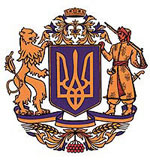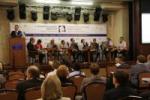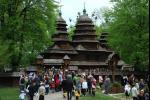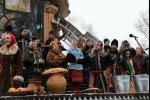- عربي
- Ukraine
- Economy
-
Investment
- Current Investment Trends
- Legal Conditions of Doing Business
- Investment Policy
- Competition
- Setting a Business in Ukraine
- Mergers and Acquisitions
- Taxation
- Import and Export
- Banks and Bank Regulation
- Convertibility and Profits Repatriation
- Currency Regulation
- Protection of Intellectual Property Rights
- Companies
- Travel to Ukraine
- About us
- Useful Sites
- Gallery
- News
Currency rates in UAH
| AED | ||
| BHD | ||
| EGP | ||
| KWD | ||
| LBP | ||
| OMR | ||
| QAR | ||
| SAR | ||
| SYP |
2015-07-06
| Kiev |  |
+32 |
| Donetsk |  |
+28 |
| Dnipropetrovsk |  |
+31 |
| Lviv |  |
+31 |
| Odessa |  |
+27 |
Ukrainian Symbols
According to the Constitution of Ukraine the state symbols of the country are:
• The State Flag of Ukraine
• The State Coat of Arms of Ukraine
• The State Anthem of Ukraine
The State Flag of Ukraine
The State Flag is a banner made of two equally dividing horizontal bars of blue and yellow.
The colors symbolized the Kyivan State even before the Rus was baptized. During the times of the Tartar yoke of Baty-khan, this symbolism disappeared to be revived later on in the church ritual decorations and blazonry of Ukrainian towns. The coats of arms of the towns in the Kyiv region and generally throughout Ukraine were framed in the yellow-sky blue colors. Since the 17th century, the regimental and company banners of Cossacks were made of blue cloth with the cross, stars, weapons and images of saints drawn with yellow paint on it.
The evolution of the external national attributes continued in the 20th century when on March 22, 1918, the yellow-blue flag was approved by the Central Rada. Under the Hetman Pavlo Skoropadsky’s government, the order of colors was altered to be blue-yellow.
By the Decree, the Verkhovna Rada approved the blue-yellow flag as the Banner of Independent Ukraine on January 28, 1992.
The State Coat of Arms of Ukraine
In accordance with the Constitution, the Major State Coat of Arms of Ukraine is to be established with the Minor State Coat of Arms of Ukraine and the Coat of Arms of the Cossack Army of Zaporizhia taken into account as its chief elements. The principal element of the Major State Coat of Arms of Ukraine is the trident (the Minor State Emblem), the Symbol of the Princely State of Volodymyr the Great.
From the antiquity revered as a magic sign and a kind of charm, the trident symbolized the division of the Universe into the heavenly, earthy, and one beyond; the combination of the divine, motherly and fatherly, the sacred origin and three natural elements–the air, water and earth. Archeologist encountered the image in the numerous cultural artifacts of the past dated back to the 1st century, while the first record of the signs belongs to the 10th century A.D.
While signing a treaty with Byzantium, the ambassadors of the Kyivan Prince Ihor (912 to 945) used the trident in their seals. During the Kyivan Rus, the trident became the symbol of the great princedom with its image found be archeologists in coins, seals, crockery, bricks, as well as wall-paintings. The Kyiv prince Volodymyr Sviatoslavych (980 to 1015) coined money with the image of the Master on one side and trident on the other.
In December 1917, the Ukrainian Central Rada adopted the trident as a Symbol of the Ukrainian People’s Republic; since January 22, 1919, in accordance with the Decree on Unification it became part of the regional coat of arms of the Western oblast of the UPR. It remained the principal element of the Pavlo Skoropadsky’s Hetman State, and also for the Directoria. Constitutionally, the all-Ukrainian National Rada first adopted the trident as the State Coat of Arms in May of 1920. It also became the State Coat of Arms of the Carpathian Rus in 1939 when they declared independence after the Czechoslovak Republic broke up.
Officially discredited in Ukraine under the Soviets, the trident still remained as the symbol of the national liberation movement.
The decreed enactment “On the State Coat of Arms of Ukraine” by the Verkhovna Rada on February 19, 1992, the trident was approved as the Small State Coat of Arms and principal element of the Great State Coat of Arms.
The latter has not yet been approved, although the development of its conception continues to be based on elements that reflect the historical pathway towards the Ukrainian independence. The principal components of the Great State Coat of Arms should become an element of the Coats of Arms of the Cossack Army of Zaporizhia and the Galycia and Volynia Principality: Cossack with a musket and Golden Lion that hold the shield and act as protectors and successors to the State Coat of Arms of the Great Princedom period. The choice of exactly these figures arises from the wish to combine in a single symbol Western and Eastern parts of Ukraine divided historically for too long.
The State Anthem of Ukraine
The State Anthem of Ukraine, whose performance starts and ends the official ceremonies of the state importance, had been set to the music by Mykhailo Verbytsky and verse by Pavlo Chubynsky.
Creation of the Ukrainian anthem harks back to the beginning of 1862 when Pavlo Chubynsky, the Ukrainian ethnographer, folklorist and poet, wrote a poem Ukraine Has Not Died Yet that spread instantly among the circles Ukrainophiles recently unified into the Hromada, which was a liberal organization of Ukrainian bourgeois intelligentsia of the period. This patriotic verse caught the attention of the religious figures and one of them was Father Mykhailo (Verbytsky), quite a famous composer of the time was fascinated by the poem and composed the music to it.
Published for the first time in 1865, it came to be used as the national anthem since 1917.
During 1917 to 1920, Ukraine's glory hasn't perished was not approved as the single state anthem: other hymns were also performed. Throughout the course of the Soviet period of the Ukrainian history this national anthem was officially forced into oblivion.
On March 6, 2003, that the Verkhovna Rada of Ukraine approved the Decree “On the State Anthem of Ukraine”. In accordance with it, the music of Mykhailo Verbytsky with only the first couplet and refrain of the Pavlo Chubynsky song Ukraine's glory hasn't perished was confirmed to be the State Anthem of the country.




